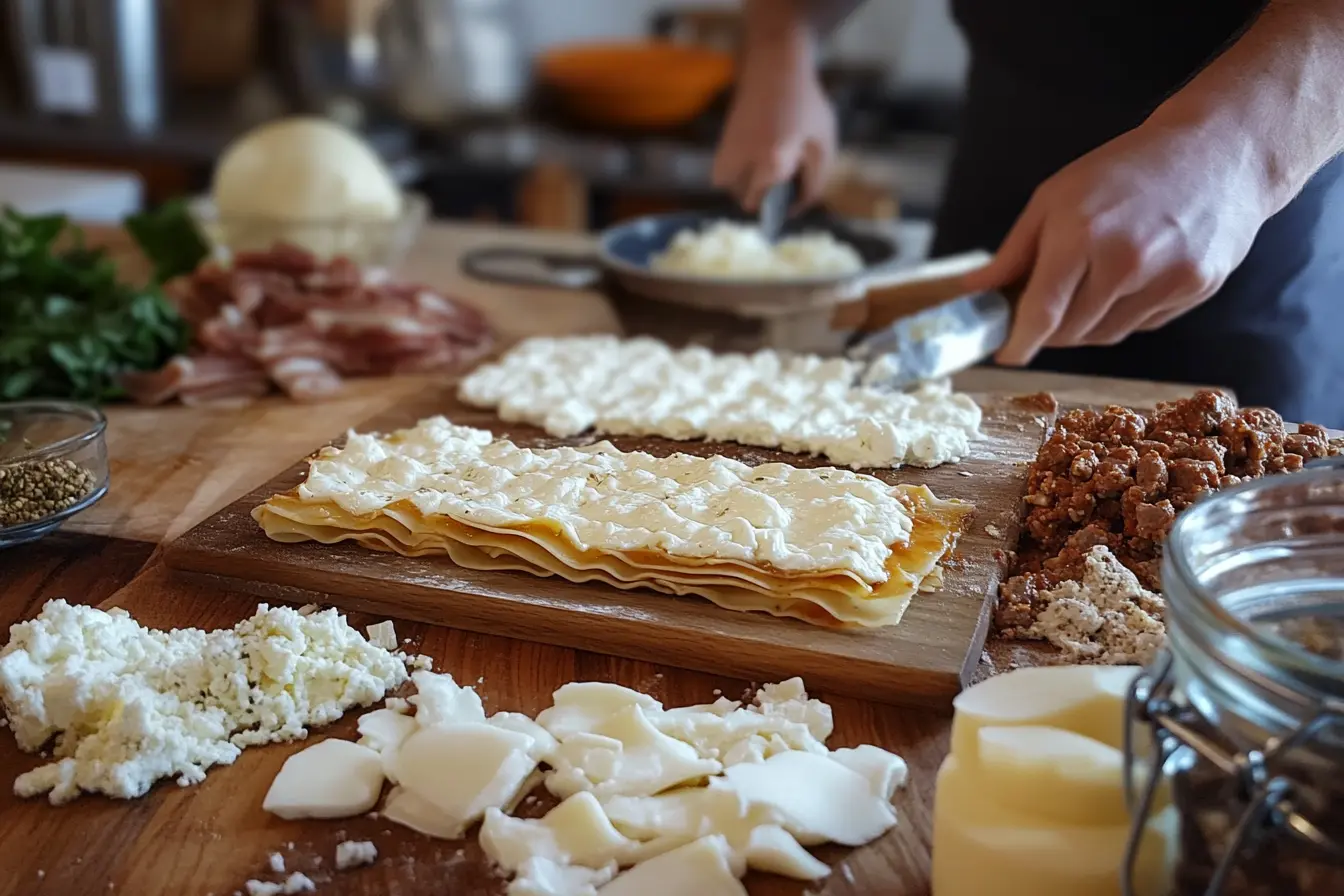What to add to lasagna to make it taste better?
Enhancing Your Lasagna: Ingredients and Techniques
Lasagna, a classic dish loved by many, holds an irresistible charm with its layers of pasta, gooey cheese, and savory sauce. But let’s face it—there’s always room for improvement. Whether you’re a seasoned cook or a novice in the kitchen, understanding what to add to lasagna to make it taste better can transform a good dish into an unforgettable masterpiece.
From selecting the freshest ingredients to using expert layering techniques, every step matters. In this article, we’ll dive into the nitty-gritty of elevating lasagna. You’ll learn how to enhance flavors with the right meats, cheeses, herbs, and vegetables, alongside crucial tips for crafting the perfect sauce. By the end, your lasagna will leave everyone asking for seconds—and the recipe!
Moving to the next part, we’ll explore the vital role of choosing high-quality ingredients. Let’s dig in!
Selecting Quality Meats for a Flavorful Base
The foundation of a remarkable lasagna lies in its savory, well-seasoned meat layer. By choosing the right combination of meats, you can create a robust base that enhances the dish’s overall taste.
The Beef and Pork Combination
Using a mix of ground beef and pork is a game-changer when it comes to flavor. The beef provides a hearty richness, while the pork adds a subtle sweetness and fat content that keeps the meat layer juicy. This duo creates a depth of flavor that’s hard to achieve with just one type of meat. The balance of textures ensures each bite feels satisfying and indulgent. (Read more on AllRecipes)
Incorporating Italian Sausage
If you’re aiming for bold and spicy undertones, adding Italian sausage is an excellent choice. Its pre-seasoned blend of herbs and spices, like fennel and paprika, packs a flavorful punch. Removing the casing and crumbling the sausage into the mix allows the spices to disperse evenly throughout the meat layer. This addition not only enhances the overall taste but also reduces the need for extra seasoning.
Elevating the Cheese Layer
Cheese is arguably the heart of lasagna. Choosing the right type of cheese—or a combination—can take your lasagna from good to extraordinary.
Fresh Mozzarella vs. Packaged Shredded Mozzarella
Fresh mozzarella, with its creamy texture and authentic flavor, elevates the cheese layer by melting into a smooth, gooey topping. In contrast, packaged shredded mozzarella, while convenient, often contains anti-caking agents that can hinder its meltability. Opting for fresh mozzarella ensures a more luxurious and evenly melted layer that perfectly complements the dish.
Ricotta or Cottage Cheese: Which to Choose?
The debate between ricotta and cottage cheese often comes down to texture and taste preferences. Ricotta provides a creamy and slightly grainy texture, adding authenticity to traditional lasagna recipes. On the other hand, cottage cheese offers a lighter, milder flavor and is a lower-calorie option. Whichever you choose, blending it with herbs like parsley and basil can elevate its flavor.
Crafting a Rich and Savory Sauce
The sauce is the soul of any lasagna, binding all the layers together with its bold flavors. A well-crafted sauce can make all the difference.
Homemade vs. Store-Bought Sauces
Homemade sauces allow for customization and a fresher, richer taste. By using ripe tomatoes, garlic, and herbs, you control every ingredient, avoiding excess preservatives or sodium found in store-bought options. For busy days, quality store-bought sauces are acceptable, but always look for those with minimal additives for the best flavor.
Secret Ingredients for Depth
Adding a few “secret ingredients” can give your sauce a unique twist. A splash of balsamic vinegar enhances the sweetness of tomatoes, while a small amount of anchovy paste adds an umami boost without overpowering the dish. These unexpected additions can set your lasagna apart and leave guests wondering about the magic ingredient.
Balancing Acidity with Sugar and Baking Soda
Tomatoes are naturally acidic, and balancing this acidity is crucial for a well-rounded sauce. Adding a pinch of sugar or a tiny bit of baking soda can neutralize excessive tanginess, creating a smooth, palatable flavor profile.
The Role of Fresh Herbs
Fresh herbs are a cornerstone of Italian cuisine, and incorporating them into your lasagna can amplify its authenticity and flavor. These aromatic additions infuse every bite with a vibrant and earthy quality that dried herbs often can’t match.
Basil, Oregano, and Thyme
Basil, with its sweet and peppery notes, is a classic herb that pairs beautifully with tomato-based sauces. Adding fresh basil to your sauce just before layering creates a fragrant aroma that complements the rich, savory components of lasagna. Oregano, on the other hand, brings a bold, slightly bitter flavor that enhances the overall complexity of the dish. Lastly, thyme introduces subtle, woody undertones that round out the herbal medley, making every bite more harmonious and layered in flavor.
Incorporating Fresh Parsley
Parsley often plays a supporting role in Italian recipes, but its bright and clean flavor shouldn’t be overlooked. Adding fresh parsley to the ricotta or cheese layer not only enhances its taste but also introduces a hint of freshness that balances the dish’s richness. Sprinkle chopped parsley over the top for a garnish that adds both color and a burst of flavor.
Spices That Make a Differenc
When it comes to spices, even small additions can make a significant impact. Strategic use of certain spices can elevate lasagna from ordinary to exceptional.
Adding Nutmeg to the Cheese Mixture
A dash of nutmeg in the cheese layer might sound surprising, but it’s a secret weapon in Italian cooking. This warm spice enhances the creaminess of ricotta or cottage cheese, creating a deeper, more nuanced flavor. The key is moderation—just a pinch is enough to add complexity without overwhelming the dish.
Using Red Pepper Flakes for Subtle Heat
For those who enjoy a touch of heat, red pepper flakes are a simple yet effective addition. Adding a small amount to your sauce introduces a gentle spiciness that complements the dish’s savory elements. This spice doesn’t overpower but rather enhances the overall flavor, giving your lasagna a well-rounded and slightly adventurous twist.
The Art of Layering
Creating a visually appealing and evenly cooked lasagna requires mastering the art of layering. Each layer plays a role in delivering a balanced flavor and delightful texture, so it’s essential to get this technique right.
Optimal Noodle Placement
The placement of your noodles can make or break the structure of your lasagna. Begin with a light coating of sauce at the bottom of the pan to prevent sticking, then add your first layer of noodles. Ensure that the noodles slightly overlap, forming a solid base that supports the weight of the subsequent layers. This arrangement not only prevents the layers from collapsing but also helps the noodles cook evenly.
Balancing Sauce and Cheese Layers
Striking the right balance between sauce and cheese is crucial for a flavorful and cohesive lasagna. Too much sauce can lead to soggy layers, while too much cheese may overpower other flavors. A good rule of thumb is to spread a thin but even layer of sauce over the noodles, followed by a generous but not excessive layer of cheese. This balance ensures every bite is flavorful without being overwhelming.
Achieving Multiple Layers for Complexity
For a lasagna with depth and complexity, aim for at least three to four layers. Each additional layer introduces new opportunities for the flavors to meld together during baking. This approach enhances the dish’s texture and ensures that every forkful includes a perfect combination of noodles, sauce, and cheese.
Baking Tips for Perfect Results
The baking process is just as important as the preparation. Following the right techniques ensures that your lasagna comes out evenly cooked and visually stunning.
Covering with Foil vs. Baking Uncovered
Covering your lasagna with foil during the initial baking phase traps heat and moisture, allowing the noodles to cook evenly and the flavors to meld together. About 10-15 minutes before the lasagna is fully baked, removing the foil lets the top layer of cheese achieve a golden-brown crust. This dual approach ensures a beautifully cooked and aesthetically pleasing lasagna.
Letting the Lasagna Rest Before Serving
Patience pays off when it comes to serving lasagna. Allowing the dish to rest for 15-20 minutes after baking is essential for optimal presentation and taste. This resting period helps the layers set, preventing them from collapsing when sliced. The result? Perfectly defined layers that not only look stunning but also deliver a harmonious blend of flavors in every bite.
Incorporating Vegetables for Added Flavor
Vegetables can bring a new dimension to lasagna, enhancing its flavor profile while adding nutritional benefits. By carefully selecting and preparing the right vegetables, you can elevate the dish without overpowering its classic taste.
Sautéed Spinach or Kale
Greens like spinach or kale are fantastic additions to lasagna. Sautéing them with a touch of olive oil and garlic before layering ensures they blend seamlessly into the dish. Spinach adds a mild, slightly sweet flavor, while kale provides an earthier note. Both options introduce a burst of nutrients and a subtle layer of complexity that enhances the overall experience.
Roasted Red Peppers or Zucchini
Roasted vegetables like red peppers or zucchini add a touch of sweetness and a delightful texture to lasagna. The roasting process caramelizes the natural sugars in these vegetables, giving them a rich, smoky flavor. Thinly slicing and layering them between the noodles creates pockets of vibrant taste, while their soft texture melds beautifully with the cheese and sauce.
Serving Suggestions to Complement Your Lasagna
Pairing your lasagna with thoughtful sides can complete the meal, creating a harmonious dining experience that highlights the dish’s richness.
Pairing with Garlic Bread
Few combinations are as satisfying as lasagna and garlic bread. The crusty bread, infused with buttery garlic and herbs, is the perfect vehicle for mopping up any leftover sauce on your plate. Its crispy exterior and soft interior provide a delightful contrast to the creamy layers of lasagna, making each bite more enjoyable.
Fresh Side Salads
A fresh side salad offers a refreshing counterpoint to the hearty lasagna. Crisp greens like arugula or romaine, tossed with cherry tomatoes, cucumbers, and a light vinaigrette, provide a zesty and crunchy element that balances the dish’s richness. You could also opt for a simple Caesar salad for a classic pairing that never fails to impress.
FAQs About Enhancing Lasagna Flavor
Lasagna lovers often have questions about how to perfect their favorite dish. Below are answers to some common queries that will help you refine your recipe and cooking technique.
Can I use no-boil noodles without compromising taste?
Absolutely! No-boil noodles are not only convenient but also absorb flavors beautifully during baking. Their texture becomes perfectly tender as they cook in the sauce, making them a great alternative to traditional noodles. (Learn more at Epicurious)
What’s the best way to reheat lasagna without drying it out?
To reheat lasagna while keeping it moist, cover the dish tightly with foil and bake it at 350°F until heated through. This method traps steam, ensuring the layers stay juicy and flavorful. Avoid microwaving unless you’re in a pinch, as it can dry out the pasta and cheese.
How can I make a vegetarian lasagna taste rich and savory?
Vegetarian lasagna can be as satisfying as its meat-based counterpart by using umami-rich ingredients like mushrooms, sun-dried tomatoes, and roasted vegetables. Adding a robust homemade sauce and plenty of cheese ensures a depth of flavor that rivals traditional recipes.
Is it necessary to add egg to the ricotta mixture?
Adding an egg to the ricotta mixture is optional but highly recommended. It acts as a binder, giving the cheese layer a firmer texture that holds its shape during baking. Without the egg, the ricotta may become slightly runny, though it still tastes delicious.

